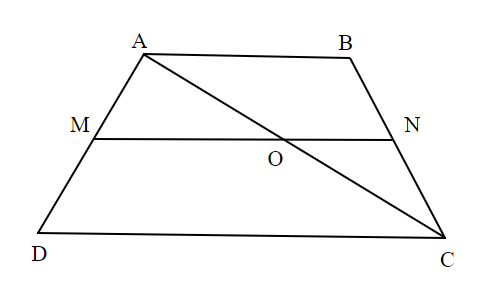
Answer
497.4k+ views
Hint: A trapezium is a 2D shape which falls under the category of quadrilaterals. A trapezium has two parallel sides and two non-parallel sides. Using this information first draw the diagram with the given data and solve the problem accordingly.
Complete step-by-step answer:
In the given trapezium ABCD, \[\overline {AB} \parallel \overline {CD} \], \[M\] and \[N\]are the points on the traversals \[\overleftrightarrow {AD}\] and \[\overleftrightarrow {BC}\] respectively as shown in the below diagram.

Also, given \[\dfrac{{AM}}{{MD}} = \dfrac{{BN}}{{NC}} = \dfrac{2}{3}\]
So, clearly from the diagram, \[\overline {MN} \parallel \overline {AB} \] and \[\overline {AB} \parallel \overline {CD} \].
Given that diagonal \[\overline {AC} \] intersects \[\overline {MN} \] at \[O\].
In \[\Delta ADC\], \[\overline {MO} \parallel \overline {DC} \] such that \[M \in \overline {AD} {\text{ }}\& {\text{ }}O \in \overline {AC} \].
We know that by the Triangle Proportionality theorem, if a line parallel to one side of a triangle intersects the other two sides of the triangle, then the lines divide these two sides proportionally.
By using this property in \[\Delta ADC\], we have
\[ \Rightarrow \dfrac{{AM}}{{MD}} = \dfrac{{AO}}{{OC}}\]
But we have \[\dfrac{{AM}}{{MD}} = \dfrac{2}{3}\]
So, \[\dfrac{{AO}}{{OC}} = \dfrac{2}{3}\]
We have to find \[\dfrac{{AO}}{{AC}}\]. From the diagram, \[OC = AO + OC\]
\[
\Rightarrow \dfrac{{AO}}{{OC}} = \dfrac{{AO}}{{AO + OC}} \\
\Rightarrow \dfrac{{AO}}{{OC}} = \dfrac{2}{{2 + 3}} \\
\therefore \dfrac{{AO}}{{OC}} = \dfrac{2}{5} \\
\]
Thus, \[\dfrac{{AO}}{{OC}} = \dfrac{2}{5}\].
Note: The length of the mid-segment is equal to half of the sum of parallel bases in a trapezium. In this problem we have used both the properties of triangles as well as the properties of trapezium.
Complete step-by-step answer:
In the given trapezium ABCD, \[\overline {AB} \parallel \overline {CD} \], \[M\] and \[N\]are the points on the traversals \[\overleftrightarrow {AD}\] and \[\overleftrightarrow {BC}\] respectively as shown in the below diagram.

Also, given \[\dfrac{{AM}}{{MD}} = \dfrac{{BN}}{{NC}} = \dfrac{2}{3}\]
So, clearly from the diagram, \[\overline {MN} \parallel \overline {AB} \] and \[\overline {AB} \parallel \overline {CD} \].
Given that diagonal \[\overline {AC} \] intersects \[\overline {MN} \] at \[O\].
In \[\Delta ADC\], \[\overline {MO} \parallel \overline {DC} \] such that \[M \in \overline {AD} {\text{ }}\& {\text{ }}O \in \overline {AC} \].
We know that by the Triangle Proportionality theorem, if a line parallel to one side of a triangle intersects the other two sides of the triangle, then the lines divide these two sides proportionally.
By using this property in \[\Delta ADC\], we have
\[ \Rightarrow \dfrac{{AM}}{{MD}} = \dfrac{{AO}}{{OC}}\]
But we have \[\dfrac{{AM}}{{MD}} = \dfrac{2}{3}\]
So, \[\dfrac{{AO}}{{OC}} = \dfrac{2}{3}\]
We have to find \[\dfrac{{AO}}{{AC}}\]. From the diagram, \[OC = AO + OC\]
\[
\Rightarrow \dfrac{{AO}}{{OC}} = \dfrac{{AO}}{{AO + OC}} \\
\Rightarrow \dfrac{{AO}}{{OC}} = \dfrac{2}{{2 + 3}} \\
\therefore \dfrac{{AO}}{{OC}} = \dfrac{2}{5} \\
\]
Thus, \[\dfrac{{AO}}{{OC}} = \dfrac{2}{5}\].
Note: The length of the mid-segment is equal to half of the sum of parallel bases in a trapezium. In this problem we have used both the properties of triangles as well as the properties of trapezium.
Recently Updated Pages
Fill in the blanks with suitable prepositions Break class 10 english CBSE

Fill in the blanks with suitable articles Tribune is class 10 english CBSE

Rearrange the following words and phrases to form a class 10 english CBSE

Select the opposite of the given word Permit aGive class 10 english CBSE

Fill in the blank with the most appropriate option class 10 english CBSE

Some places have oneline notices Which option is a class 10 english CBSE

Trending doubts
Fill the blanks with the suitable prepositions 1 The class 9 english CBSE

How do you graph the function fx 4x class 9 maths CBSE

Which are the Top 10 Largest Countries of the World?

What is the definite integral of zero a constant b class 12 maths CBSE

The Equation xxx + 2 is Satisfied when x is Equal to Class 10 Maths

Differentiate between homogeneous and heterogeneous class 12 chemistry CBSE

Define the term system surroundings open system closed class 11 chemistry CBSE

Full Form of IASDMIPSIFSIRSPOLICE class 7 social science CBSE

Change the following sentences into negative and interrogative class 10 english CBSE




